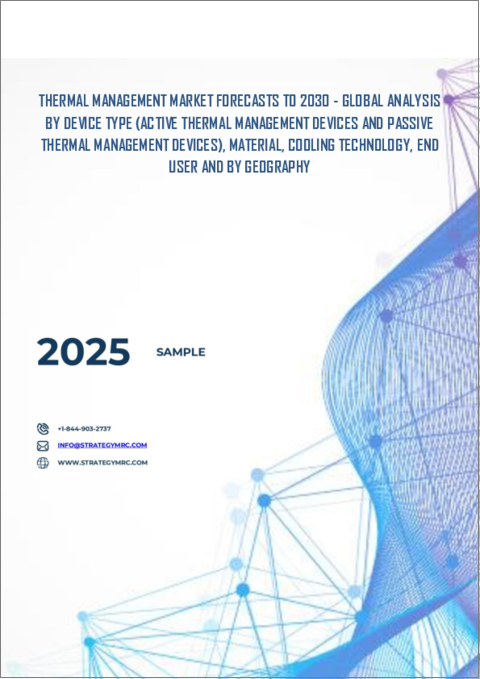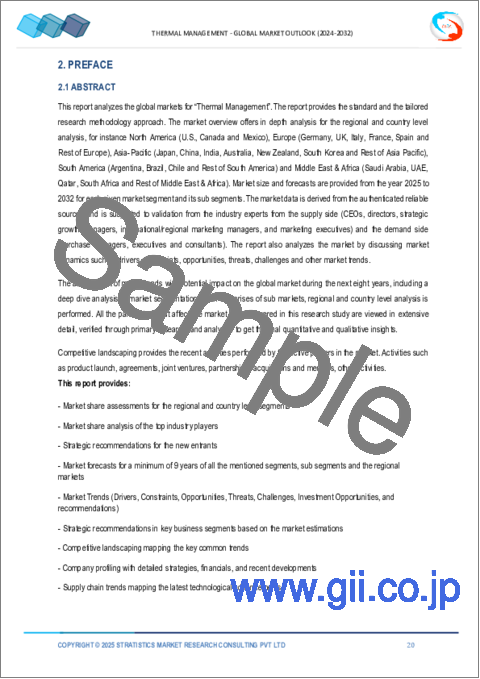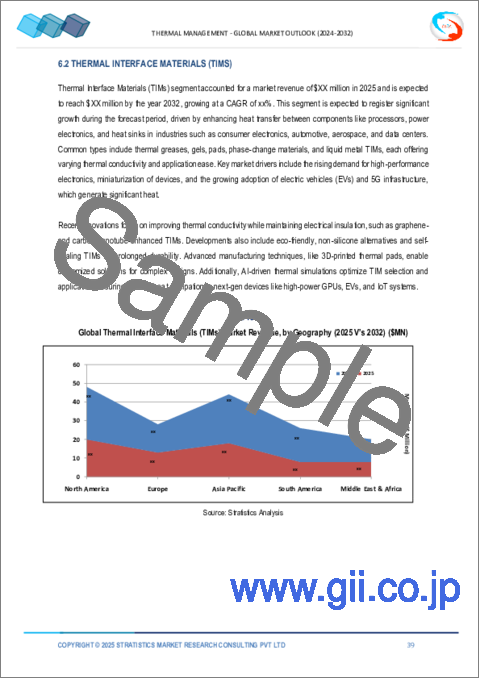|
|
市場調査レポート
商品コード
1679211
熱管理市場の2030年までの予測: デバイスタイプ、材料、冷却技術、エンドユーザー、地域別の世界分析Thermal Management Market Forecasts to 2030 - Global Analysis By Device Type (Active Thermal Management Devices and Passive Thermal Management Devices), Material, Cooling Technology, End User and By Geography |
||||||
カスタマイズ可能
|
|||||||
| 熱管理市場の2030年までの予測: デバイスタイプ、材料、冷却技術、エンドユーザー、地域別の世界分析 |
|
出版日: 2025年03月03日
発行: Stratistics Market Research Consulting
ページ情報: 英文 200+ Pages
納期: 2~3営業日
|
全表示
- 概要
- 図表
- 目次
Stratistics MRCによると、世界の熱管理市場は2024年に108億9,000万米ドルを占め、2030年にはCAGR11.5%で成長し、224億3,000万米ドルに達すると予測されています。
熱管理とは、システム、デバイス、コンポーネントの温度を調整し、最適な性能、効率、寿命を確保するために使用される技術やプロセスを指します。過度の熱が故障や効率低下の原因となるエレクトロニクス、自動車、航空宇宙、産業用アプリケーションでは極めて重要です。効果的な熱管理は信頼性を高め、過熱を防止し、エネルギー効率を維持するため、現代の工学および技術設計の重要な側面となっています。
International Journal of Modeling and Optimization and Cooling Indiaによると、データセンターのエネルギー消費の30~55%は電力冷却と換気システムに使われています。
コンシューマー・エレクトロニクスの需要増加
機器の小型化・高性能化に伴い、発熱量も増加し、性能低下やハードウェアの故障を防ぐための効率的な冷却ソリューションが求められています。ヒートパイプ、熱インターフェース材料(TIM)、相変化材料などの高度な熱管理技術は、デバイスの効率と寿命の維持に役立ちます。メーカーは革新的な冷却ソリューションに継続的に投資することで、市場の成長を促進し、最新の電子機器における最適な熱性能を確保しています。
複雑な設計と統合
エレクトロニクス、自動車、産業システムなど、さまざまな用途に合わせてカスタマイズされたソリューションが必要なため、熱管理には複雑な設計と統合が必要です。さまざまな熱負荷、スペースの制約、材料の互換性、効率要件などの課題が、効果的な冷却システムの設計を困難にしています。このような複雑さは、開発時間、コスト、熟練した専門知識の必要性を増大させ、採用を制限することで市場の成長を妨げます。
AIとデータセンターの進歩
AI主導のワークロード、クラウド・コンピューティング、エッジ・コンピューティングは膨大な熱を発生させるため、過熱を防ぎ最適なパフォーマンスを確保する効率的な冷却ソリューションが必要となります。高密度データセンターでは、エネルギー効率の向上と運用コストの削減のため、液冷、液浸冷却、AIを活用した熱最適化などの高度な冷却技術が求められています。世界のデータトラフィックの増加とハイパースケールデータセンターの拡大に伴い、企業は革新的な熱管理ソリューションに投資しています。さらに、持続可能性への懸念が環境に優しい冷却方法を後押しし、市場の成長をさらに加速させています。
技術的課題
電力密度の増加、電子部品の小型化、コンパクトなスペースでの高効率冷却の必要性により、熱管理は技術的課題に直面しています。先進的な冷却ソリューションの開発には大規模な研究開発が必要で、コストが上昇します。性能を損なうことなく、これらの技術を複雑なシステムに統合することは困難です。さらに、材料の制限や持続可能で環境に優しいソリューションの必要性が、開発をさらに複雑にし、市場拡大の妨げとなっています。
COVID-19の影響:
COVID-19の大流行は、サプライチェーンの遅延、原材料不足、製造能力の低下を引き起こし、熱管理市場を混乱させました。当初は自動車と産業部門の減速が成長の妨げとなったが、パンデミック後の電気自動車と5Gインフラの急速な普及が市場の回復を後押ししました。全体として、この危機は熱管理における技術革新を加速させ、将来の設計における信頼性、エネルギー効率、持続可能性を強調しました。
予測期間中、セラミックベースのソリューションセグメントが最大になる見込み
予測期間中、セラミックベースのソリューションセグメントが最大の市場シェアを占めると予想されます。熱管理におけるセラミックベースのソリューションは、優れた耐熱性、高い熱伝導性、電気絶縁性を備えており、エレクトロニクス、自動車、航空宇宙産業などの用途に最適です。高性能、軽量、持続可能な熱管理ソリューションに対する需要の高まりにより、採用が拡大しています。
予測期間中、データセンター・サーバー分野のCAGRが最も高くなる見込み
予測期間中、データセンター・サーバー分野が最も高い成長率を示すと予測されています。データセンターとサーバーの熱管理は、最適なパフォーマンスを維持し、過熱を防ぎ、エネルギー効率を確保するために極めて重要です。AI、クラウドコンピューティング、5Gによるデータ処理需要の増加に伴い、液冷、液浸冷却、高度なエアフロー管理などの効果的な冷却ソリューションが不可欠です。
最大のシェアを占める地域
予測期間中、民生用電子機器、電気自動車(EV)、データセンターの拡大により、アジア太平洋地域が最大の市場シェアを占めると予想されます。中国、日本、韓国、インドなどの国々は、強力な製造基盤と技術的進歩により主要プレーヤーとなっています。5Gネットワーク、産業オートメーション、スマートデバイスの台頭が需要をさらに押し上げています。全体として、アジア太平洋地域は熱管理ソリューションの市場として支配的であり、競争も激しいです。
CAGRが最も高い地域:
予測期間中、北米地域は電気自動車(EV)、データセンター、航空宇宙、民生用電子機器の進歩により、最も高いCAGRを示すと予測されます。米国は、AI、クラウドコンピューティング、5Gインフラへの大規模な投資により、効率的な冷却ソリューションの需要を高め、同地域をリードしています。EV導入の増加と厳しいエネルギー効率規制が市場成長をさらに後押ししています。全体として、北米は熱管理の革新と採用における主要プレーヤーであり続けています。
無料カスタマイズサービス:
本レポートをご購読のお客様には、以下の無料カスタマイズオプションのいずれかをご利用いただけます:
- 企業プロファイル
- 追加市場企業の包括的プロファイリング(3社まで)
- 主要企業のSWOT分析(3社まで)
- 地域セグメンテーション
- 顧客の関心に応じた主要国の市場推計・予測・CAGR(注:フィージビリティチェックによる)
- 競合ベンチマーキング
- 製品ポートフォリオ、地理的プレゼンス、戦略的提携に基づく主要企業のベンチマーキング
目次
第1章 エグゼクティブサマリー
第2章 序文
- 概要
- ステークホルダー
- 調査範囲
- 調査手法
- データマイニング
- データ分析
- データ検証
- 調査アプローチ
- 調査情報源
- 1次調査情報源
- 2次調査情報源
- 前提条件
第3章 市場動向分析
- 促進要因
- 抑制要因
- 機会
- 脅威
- 技術分析
- エンドユーザー分析
- 新興市場
- COVID-19の影響
第4章 ポーターのファイブフォース分析
- 供給企業の交渉力
- 買い手の交渉力
- 代替品の脅威
- 新規参入業者の脅威
- 競争企業間の敵対関係
第5章 世界の熱管理市場:デバイスタイプ別
- アクティブ熱管理デバイス
- ファンとブロワー
- ヒートシンク
- 熱電冷却器
- 液体冷却システム
- パッシブ熱管理デバイス
- ヒートパイプ
- 断熱
- 蒸気チャンバー
第6章 世界の熱管理市場:材料別
- 熱伝導性材料(TIM)
- 金属ベースのソリューション
- セラミックベースのソリューション
- ナノマテリアル
- その他の材料
第7章 世界の熱管理市場:冷却技術別
- 伝導冷却
- 対流冷却
- ハイブリッド冷却システム
- 二相冷却
- その他の冷却技術
第8章 世界の熱管理市場:エンドユーザー別
- 自動車
- 家電
- データセンターとサーバー
- ヘルスケア
- 航空宇宙および防衛
- 工業・製造業
- エネルギーと電力
- その他のエンドユーザー
第9章 世界の熱管理市場:地域別
- 北米
- 米国
- カナダ
- メキシコ
- 欧州
- ドイツ
- 英国
- イタリア
- フランス
- スペイン
- その他の欧州
- アジア太平洋
- 日本
- 中国
- インド
- オーストラリア
- ニュージーランド
- 韓国
- その他のアジア太平洋
- 南米
- アルゼンチン
- ブラジル
- チリ
- その他の南米
- 中東・アフリカ
- サウジアラビア
- アラブ首長国連邦
- カタール
- 南アフリカ
- その他の中東・アフリカ
第10章 主な発展
- 契約、パートナーシップ、コラボレーション、合弁事業
- 買収と合併
- 新製品発売
- 事業拡大
- その他の主要戦略
第11章 企業プロファイリング
- Honeywell International Inc.
- Vertiv Holdings Co.
- Coherent Corporation
- Laird Thermal Systems
- Advanced Cooling Technologies, Inc.
- Delta Electronics, Inc.
- Henkel AG & Company, KGaA
- Parker Chomerics
- Prestone Limited
- Autoneum Holding AG
- European Thermodynamics Ltd.
- Aavid Thermalloy LLC
- Heatex AB
- Lord Corporation
- Dau Thermal Solutions Inc.
- Gentherm Inc.
- Thermacore Inc.
- Pentair Thermal Management
- Outlast Technologies LLC
- Clariant AG
List of Tables
- Table 1 Global Thermal Management Market Outlook, By Region (2022-2030) ($MN)
- Table 2 Global Thermal Management Market Outlook, By Device Type (2022-2030) ($MN)
- Table 3 Global Thermal Management Market Outlook, By Active Thermal Management Devices (2022-2030) ($MN)
- Table 4 Global Thermal Management Market Outlook, By Fans & Blowers (2022-2030) ($MN)
- Table 5 Global Thermal Management Market Outlook, By Heat Sinks (2022-2030) ($MN)
- Table 6 Global Thermal Management Market Outlook, By Thermoelectric Coolers (2022-2030) ($MN)
- Table 7 Global Thermal Management Market Outlook, By Liquid Cooling Systems (2022-2030) ($MN)
- Table 8 Global Thermal Management Market Outlook, By Passive Thermal Management Devices (2022-2030) ($MN)
- Table 9 Global Thermal Management Market Outlook, By Heat Pipes (2022-2030) ($MN)
- Table 10 Global Thermal Management Market Outlook, By Thermal Insulation (2022-2030) ($MN)
- Table 11 Global Thermal Management Market Outlook, By Vapor Chambers (2022-2030) ($MN)
- Table 12 Global Thermal Management Market Outlook, By Material (2022-2030) ($MN)
- Table 13 Global Thermal Management Market Outlook, By Thermal Interface Materials (TIMs) (2022-2030) ($MN)
- Table 14 Global Thermal Management Market Outlook, By Metal-Based Solutions (2022-2030) ($MN)
- Table 15 Global Thermal Management Market Outlook, By Ceramic-Based Solutions (2022-2030) ($MN)
- Table 16 Global Thermal Management Market Outlook, By Nanomaterials (2022-2030) ($MN)
- Table 17 Global Thermal Management Market Outlook, By Other Materials (2022-2030) ($MN)
- Table 18 Global Thermal Management Market Outlook, By Cooling Technology (2022-2030) ($MN)
- Table 19 Global Thermal Management Market Outlook, By Conduction Cooling (2022-2030) ($MN)
- Table 20 Global Thermal Management Market Outlook, By Convection Cooling (2022-2030) ($MN)
- Table 21 Global Thermal Management Market Outlook, By Hybrid Cooling Systems (2022-2030) ($MN)
- Table 22 Global Thermal Management Market Outlook, By Two-Phase Cooling (2022-2030) ($MN)
- Table 23 Global Thermal Management Market Outlook, By Other Cooling Technologies (2022-2030) ($MN)
- Table 24 Global Thermal Management Market Outlook, By End User (2022-2030) ($MN)
- Table 25 Global Thermal Management Market Outlook, By Automotives (2022-2030) ($MN)
- Table 26 Global Thermal Management Market Outlook, By Consumer Electronics (2022-2030) ($MN)
- Table 27 Global Thermal Management Market Outlook, By Data Centers & Servers (2022-2030) ($MN)
- Table 28 Global Thermal Management Market Outlook, By Healthcare (2022-2030) ($MN)
- Table 29 Global Thermal Management Market Outlook, By Aerospace & Defense (2022-2030) ($MN)
- Table 30 Global Thermal Management Market Outlook, By Industrial & Manufacturing (2022-2030) ($MN)
- Table 31 Global Thermal Management Market Outlook, By Energy & Power (2022-2030) ($MN)
- Table 32 Global Thermal Management Market Outlook, By Other End Users (2022-2030) ($MN)
Note: Tables for North America, Europe, APAC, South America, and Middle East & Africa Regions are also represented in the same manner as above.
According to Stratistics MRC, the Global Thermal Management Market is accounted for $10.89 billion in 2024 and is expected to reach $22.43 billion by 2030 growing at a CAGR of 11.5% during the forecast period. Thermal management refers to the techniques and processes used to regulate the temperature of systems, devices, or components to ensure optimal performance, efficiency, and longevity. It is crucial in electronics, automotive, aerospace, and industrial applications where excessive heat can cause failures or reduced efficiency. Effective thermal management enhances reliability, prevents overheating, and maintains energy efficiency, making it a critical aspect of modern engineering and technology design.
According to International Journal of Modeling and Optimization and Cooling India, 30-55% of a data center's energy consumption goes to power cooling and ventilation systems.
Market Dynamics:
Driver:
Rising demand for consumer electronics
As devices become more compact and powerful, they generate higher heat levels, requiring efficient cooling solutions to prevent performance degradation and hardware failures. Advanced thermal management technologies such as heat pipes, thermal interface materials (TIMs), and phase-change materials help maintain device efficiency and longevity. Manufacturers continuously invest in innovative cooling solutions, propelling market growth and ensuring optimal thermal performance in modern electronics.
Restraint:
Complex design and integration
Thermal management involves complex design and integration due to the need for customized solutions tailored to different applications, such as electronics, automotive, and industrial systems. Factors like varying heat loads, space constraints, material compatibility, and efficiency requirements make designing effective cooling systems challenging. This complexity increases development time, costs, and the need for skilled expertise, hampering market growth by limiting adoption.
Opportunity:
Advancements in AI and data centers
AI-driven workloads, cloud computing, and edge computing generate immense heat, requiring efficient cooling solutions to prevent overheating and ensure optimal performance. High-density data centers demand advanced cooling techniques like liquid cooling, immersion cooling, and AI-powered thermal optimization to enhance energy efficiency and reduce operational costs. With increasing global data traffic and the expansion of hyperscale data centers, companies invest in innovative thermal management solutions. Additionally, sustainability concerns push for eco-friendly cooling methods, further accelerating market growth.
Threat:
Technological challenges
Thermal management faces technological challenges due to increasing power densities, miniaturization of electronic components, and the need for high-efficiency cooling in compact spaces. Developing advanced cooling solutions, requires extensive R&D, driving up costs. Integrating these technologies into complex systems without compromising performance is difficult. Additionally, material limitations and the need for sustainable, eco-friendly solutions further complicate advancements and hampers the market expansion.
Covid-19 Impact:
The covid-19 pandemic disrupted the thermal management market by causing supply chain delays, raw material shortages, and reduced manufacturing capacity. The slowdown in automotive and industrial sectors initially hampered growth, but the rapid adoption of electric vehicles and 5G infrastructure post-pandemic fuelled market recovery. Overall, the crisis accelerated innovation in thermal management, emphasizing reliability, energy efficiency, and sustainability in future designs.
The ceramic-based solutions segment is expected to be the largest during the forecast period
The ceramic-based solutions segment is expected to account for the largest market share during the forecast period. Ceramic-based solutions in thermal management offer excellent heat resistance, high thermal conductivity, and electrical insulation, making them ideal for applications in electronics, automotive, and aerospace industries. Their adoption is growing due to rising demand for high-performance, lightweight, and sustainable thermal management solutions.
The data centers & servers segment is expected to have the highest CAGR during the forecast period
Over the forecast period, the data centers & servers segment is predicted to witness the highest growth rate. Thermal management in data centers and servers is crucial for maintaining optimal performance, preventing overheating, and ensuring energy efficiency. With increasing data processing demands from AI, cloud computing, and 5G, effective cooling solutions like liquid cooling, immersion cooling, and advanced airflow management are essential.
Region with largest share:
During the forecast period, the Asia Pacific region is expected to hold the largest market share driven by the expansion of consumer electronics, electric vehicles (EVs), and data centers. Countries like China, Japan, South Korea, and India are key players due to their strong manufacturing base and technological advancements. The rise of 5G networks, industrial automation, and smart devices further boosts demand. Overall, Asia-Pacific remains a dominant and highly competitive market for thermal management solutions.
Region with highest CAGR:
Over the forecast period, the North America region is anticipated to exhibit the highest CAGR fuelled by advancements in electric vehicles (EVs), data centers, aerospace, and consumer electronics. The U.S. leads the region with significant investments in AI, cloud computing, and 5G infrastructure, increasing demand for efficient cooling solutions. The rise in EV adoption and strict energy efficiency regulations further propel market growth. Overall, North America remains a key player in thermal management innovation and adoption.
Key players in the market
Some of the key players in Thermal Management market include Honeywell International Inc., Vertiv Holdings Co., Coherent Corporation, Laird Thermal Systems, Advanced Cooling Technologies, Inc., Delta Electronics, Inc., Henkel AG & Company, KGaA, Parker Chomerics, Prestone Limited, Autoneum Holding AG, European Thermodynamics Ltd., Aavid Thermalloy LLC, Heatex AB, Lord Corporation, Dau Thermal Solutions Inc., Gentherm Inc., Thermacore Inc., Pentair Thermal Management, Outlast Technologies LLC and Clariant AG.
Key Developments:
In January 2025, Coherent Corp. has introduced the CT-Series thermoelectric coolers, designed to provide high thermal performance and reliability for applications in life sciences, medical, and industrial sectors. Positioned between Coherent's XLT and RC product lines, the CT-Series offers a mid-tier solution that balances performance with targeted cycling capabilities.
In October 2024, Prestone introduced three advanced thermal management fluids tailored for electric vehicles (EVs), each designed to meet the stringent GB29743.2 standard, which mandates electrical conductivity below 100 µS/cm to enhance battery safety. These innovations underscore Prestone's commitment to advancing EV technology by addressing critical safety and performance challenges in thermal management.
Device Types Covered:
- Active Thermal Management Devices
- Passive Thermal Management Devices
Materials Covered:
- Thermal Interface Materials (TIMs)
- Metal-Based Solutions
- Ceramic-Based Solutions
- Nanomaterials
- Other Materials
Cooling Technologies Covered:
- Conduction Cooling
- Convection Cooling
- Hybrid Cooling Systems
- Two-Phase Cooling
- Other Cooling Technologies
End Users Covered:
- Automotives
- Consumer Electronics
- Data Centers & Servers
- Healthcare
- Aerospace & Defense
- Industrial & Manufacturing
- Energy & Power
- Other End Users
Regions Covered:
- North America
- US
- Canada
- Mexico
- Europe
- Germany
- UK
- Italy
- France
- Spain
- Rest of Europe
- Asia Pacific
- Japan
- China
- India
- Australia
- New Zealand
- South Korea
- Rest of Asia Pacific
- South America
- Argentina
- Brazil
- Chile
- Rest of South America
- Middle East & Africa
- Saudi Arabia
- UAE
- Qatar
- South Africa
- Rest of Middle East & Africa
What our report offers:
- Market share assessments for the regional and country-level segments
- Strategic recommendations for the new entrants
- Covers Market data for the years 2022, 2023, 2024, 2026, and 2030
- Market Trends (Drivers, Constraints, Opportunities, Threats, Challenges, Investment Opportunities, and recommendations)
- Strategic recommendations in key business segments based on the market estimations
- Competitive landscaping mapping the key common trends
- Company profiling with detailed strategies, financials, and recent developments
- Supply chain trends mapping the latest technological advancements
Free Customization Offerings:
All the customers of this report will be entitled to receive one of the following free customization options:
- Company Profiling
- Comprehensive profiling of additional market players (up to 3)
- SWOT Analysis of key players (up to 3)
- Regional Segmentation
- Market estimations, Forecasts and CAGR of any prominent country as per the client's interest (Note: Depends on feasibility check)
- Competitive Benchmarking
- Benchmarking of key players based on product portfolio, geographical presence, and strategic alliances
Table of Contents
1 Executive Summary
2 Preface
- 2.1 Abstract
- 2.2 Stake Holders
- 2.3 Research Scope
- 2.4 Research Methodology
- 2.4.1 Data Mining
- 2.4.2 Data Analysis
- 2.4.3 Data Validation
- 2.4.4 Research Approach
- 2.5 Research Sources
- 2.5.1 Primary Research Sources
- 2.5.2 Secondary Research Sources
- 2.5.3 Assumptions
3 Market Trend Analysis
- 3.1 Introduction
- 3.2 Drivers
- 3.3 Restraints
- 3.4 Opportunities
- 3.5 Threats
- 3.6 Technology Analysis
- 3.7 End User Analysis
- 3.8 Emerging Markets
- 3.9 Impact of Covid-19
4 Porters Five Force Analysis
- 4.1 Bargaining power of suppliers
- 4.2 Bargaining power of buyers
- 4.3 Threat of substitutes
- 4.4 Threat of new entrants
- 4.5 Competitive rivalry
5 Global Thermal Management Market, By Device Type
- 5.1 Introduction
- 5.2 Active Thermal Management Devices
- 5.2.1 Fans & Blowers
- 5.2.2 Heat Sinks
- 5.2.3 Thermoelectric Coolers
- 5.2.4 Liquid Cooling Systems
- 5.3 Passive Thermal Management Devices
- 5.3.1 Heat Pipes
- 5.3.2 Thermal Insulation
- 5.3.3 Vapor Chambers
6 Global Thermal Management Market, By Material
- 6.1 Introduction
- 6.2 Thermal Interface Materials (TIMs)
- 6.3 Metal-Based Solutions
- 6.4 Ceramic-Based Solutions
- 6.5 Nanomaterials
- 6.6 Other Materials
7 Global Thermal Management Market, By Cooling Technology
- 7.1 Introduction
- 7.2 Conduction Cooling
- 7.3 Convection Cooling
- 7.4 Hybrid Cooling Systems
- 7.5 Two-Phase Cooling
- 7.6 Other Cooling Technologies
8 Global Thermal Management Market, By End User
- 8.1 Introduction
- 8.2 Automotives
- 8.3 Consumer Electronics
- 8.4 Data Centers & Servers
- 8.5 Healthcare
- 8.6 Aerospace & Defense
- 8.7 Industrial & Manufacturing
- 8.8 Energy & Power
- 8.9 Other End Users
9 Global Thermal Management Market, By Geography
- 9.1 Introduction
- 9.2 North America
- 9.2.1 US
- 9.2.2 Canada
- 9.2.3 Mexico
- 9.3 Europe
- 9.3.1 Germany
- 9.3.2 UK
- 9.3.3 Italy
- 9.3.4 France
- 9.3.5 Spain
- 9.3.9 Rest of Europe
- 9.4 Asia Pacific
- 9.4.1 Japan
- 9.4.2 China
- 9.4.3 India
- 9.4.4 Australia
- 9.4.5 New Zealand
- 9.4.9 South Korea
- 9.4.7 Rest of Asia Pacific
- 9.5 South America
- 9.5.1 Argentina
- 9.5.2 Brazil
- 9.5.3 Chile
- 9.5.4 Rest of South America
- 9.9 Middle East & Africa
- 9.9.1 Saudi Arabia
- 9.9.2 UAE
- 9.9.3 Qatar
- 9.9.4 South Africa
- 9.9.5 Rest of Middle East & Africa
10 Key Developments
- 10.1 Agreements, Partnerships, Collaborations and Joint Ventures
- 10.2 Acquisitions & Mergers
- 10.3 New Product Launch
- 10.4 Expansions
- 10.5 Other Key Strategies
11 Company Profiling
- 11.1 Honeywell International Inc.
- 11.2 Vertiv Holdings Co.
- 11.3 Coherent Corporation
- 11.4 Laird Thermal Systems
- 11.5 Advanced Cooling Technologies, Inc.
- 11.6 Delta Electronics, Inc.
- 11.7 Henkel AG & Company, KGaA
- 11.8 Parker Chomerics
- 11.9 Prestone Limited
- 11.10 Autoneum Holding AG
- 11.11 European Thermodynamics Ltd.
- 11.12 Aavid Thermalloy LLC
- 11.13 Heatex AB
- 11.14 Lord Corporation
- 11.15 Dau Thermal Solutions Inc.
- 11.16 Gentherm Inc.
- 11.17 Thermacore Inc.
- 11.18 Pentair Thermal Management
- 11.19 Outlast Technologies LLC
- 11.20 Clariant AG






